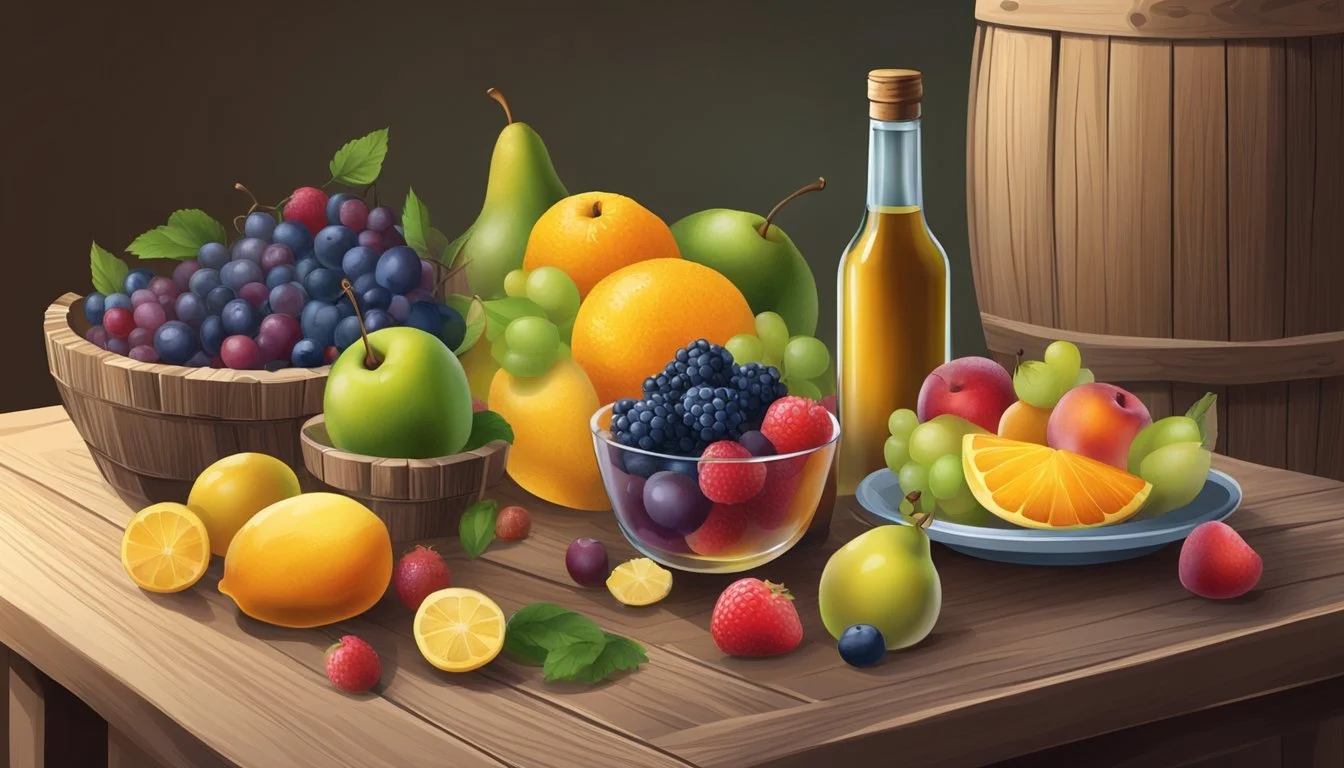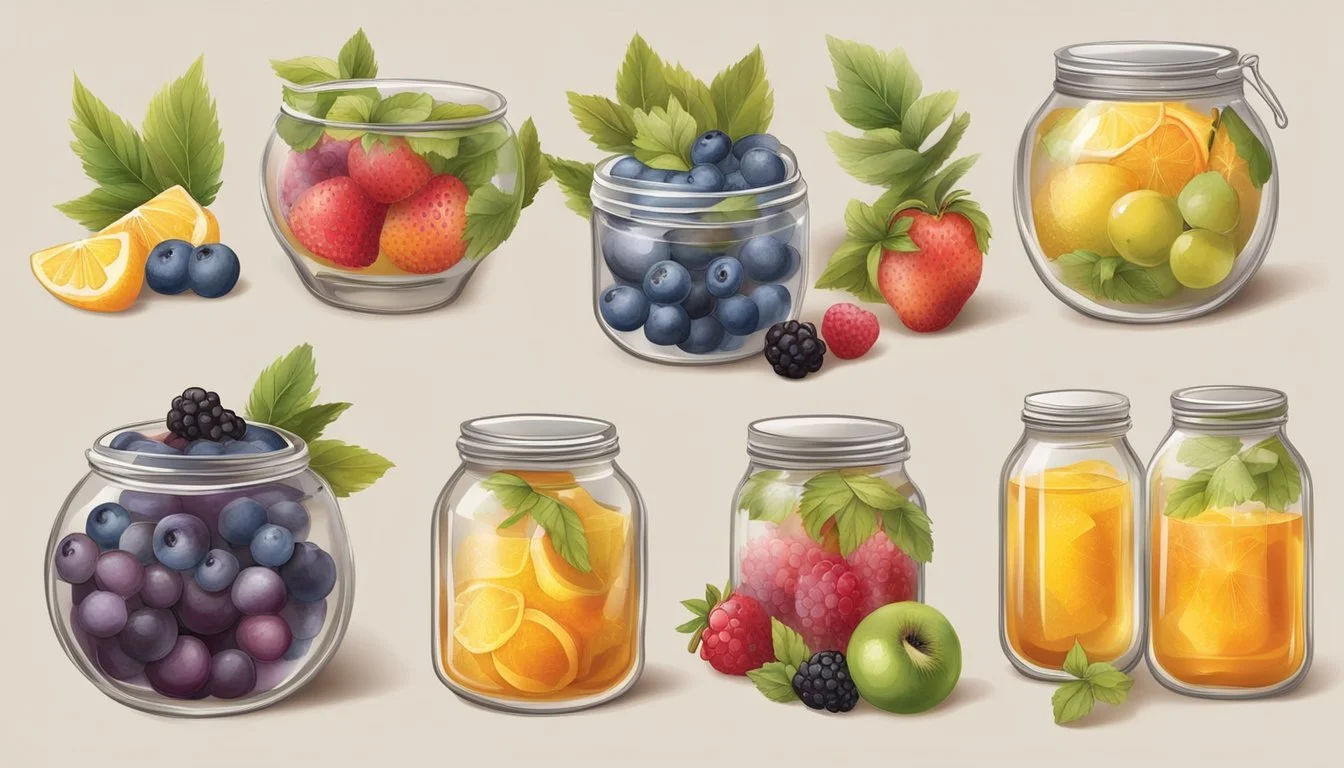Fresh vs. Frozen Fruit: Crafting the Perfect Mead Flavor Profile
Crafting the perfect melomel requires careful consideration of fruit selection and preparation. While both fresh and frozen fruits can produce excellent results, each option offers unique benefits for mead makers.
Fresh fruits provide vibrant flavors and aromas, while frozen fruits offer convenience and year-round availability. The choice between fresh or frozen often depends on factors such as seasonality, desired flavor intensity, and ease of use in the brewing process.
When using fresh fruits, mead makers can capture the essence of peak ripeness and seasonal varieties. Frozen fruits, on the other hand, allow for consistent quality and simplified preparation. Both options can yield delicious melomels when incorporated at the right stage of fermentation and in appropriate quantities.
Mead Basics
Mead is an ancient alcoholic beverage made by fermenting honey with water and yeast. It has a rich history and comes in several varieties, each with unique characteristics.
What Is Mead
Mead is often called honey wine, though it's technically distinct from grape wine. It consists of honey, water, and yeast as its core ingredients. The alcohol content typically ranges from 8% to 20%.
Mead can be dry, semi-sweet, or sweet, depending on the amount of residual sugar. Its flavor profile varies based on the type of honey used and any additional ingredients.
Some meads incorporate fruits, spices, or grains to create unique flavors. The fermentation process can take weeks to months, with aging sometimes extending to years.
History of Mead
Mead is one of the oldest alcoholic beverages, with evidence of its production dating back to 7000 BCE in China. It was popular among ancient civilizations, including the Greeks, Romans, and Vikings.
In medieval Europe, mead was often associated with nobility and special occasions. It played a significant role in mythology and literature across various cultures.
The term "honeymoon" is believed to originate from the tradition of newlyweds drinking mead for a month after their wedding. Mead's popularity declined with the rise of beer and wine but has experienced a revival in recent years.
Different Types of Mead
Traditional Mead: Made solely with honey, water, and yeast.
Melomel: Mead with fruit added.
Cyser: Mead made with apple juice or cider.
Pyment: Mead made with grapes or grape juice.
Metheglin: Mead with herbs or spices.
Braggot: Mead made with malted grains.
Bilbemel: Mead made with blueberries.
Capsicumel: Mead made with chili peppers.
Each type offers a unique flavor profile. Some meads are carbonated, while others are still. The variety of ingredients and production methods results in a wide range of mead styles, from light and refreshing to rich and complex.
Ingredients and Equipment
Creating delicious mead requires careful selection of ingredients and proper equipment. The quality of honey and fruit significantly impacts the final product, while having the right tools ensures a smooth brewing process.
Choosing the Right Honey
Raw, unpasteurized honey is ideal for mead making. It contains natural yeasts and enzymes that enhance fermentation and flavor. Lighter honeys like orange blossom or clover work well for fruit meads, allowing the fruit flavors to shine through.
Darker varieties such as buckwheat or wildflower honey can add complexity but may overpower delicate fruits. Aim for about 2-3 pounds of honey per gallon of mead.
Consider local, artisanal honey sources for unique flavor profiles. Always taste the honey before use to ensure its quality and compatibility with your chosen fruits.
Selecting Quality Fruit
Fresh, ripe fruit often yields the best flavors in mead. However, frozen fruit can be equally effective and is more convenient. Freezing breaks down cell walls, releasing more flavor and color.
For fresh fruit, choose ripe specimens without bruises or mold. Wash thoroughly and remove stems, pits, or peels as needed. Frozen fruit should be unsweetened and thawed before use.
Popular fruits for mead include berries, stone fruits, and citrus. Use 2-4 pounds of fruit per gallon of mead, adjusting based on the fruit's intensity and your desired flavor profile.
Essential Mead Making Equipment
A primary fermenter, typically a food-grade plastic bucket or glass carboy, is crucial. It should be large enough to accommodate the must and allow for foaming during fermentation.
Airlocks and rubber stoppers prevent contaminants from entering while allowing CO2 to escape. A hydrometer measures sugar content and alcohol levels.
Sanitizer is vital for cleaning all equipment to prevent spoilage. Use a no-rinse sanitizer for convenience.
Other essentials include:
Funnel for easy liquid transfer
Straining bag for fruit
Auto-siphon for racking mead
Secondary fermenter for aging
Invest in quality equipment to ensure consistent, successful mead batches.
The Role of Fruit in Mead
Fruit plays a crucial role in mead-making, contributing flavor, aroma, and nutrients to the final product. It can be used fresh or frozen, with each option offering distinct advantages for different mead styles.
Fresh vs Frozen Fruit: Pros and Cons
Fresh fruit provides vibrant flavors and aromas to mead. It contains active enzymes that can aid fermentation. However, fresh fruit is seasonal and may introduce wild yeasts or bacteria.
Frozen fruit offers convenience and year-round availability. The freezing process breaks down cell walls, potentially releasing more flavor. It's also less likely to introduce unwanted microorganisms.
Both options have their merits. Fresh fruit excels in delicate meads where subtle nuances are desired. Frozen fruit works well in robust meads or when consistency between batches is crucial.
Nutritional and Flavor Contributions of Fruit
Fruits enrich mead with vitamins, minerals, and antioxidants. These nutrients support yeast health during fermentation.
Different fruits impart unique flavors:
Berries: Tart and bold (blueberry, blackberry, raspberry)
Stone fruits: Sweet and complex (plum, peach)
Citrus: Bright and zesty (orange, lemon)
Fruits also affect mead's acidity, sweetness, and body. For example, apple juice can soften harsh flavors, while mulberries add depth and richness.
Selecting Fruit for Mead Varietals
Choosing the right fruit is key to crafting distinctive mead varietals. Popular options include:
Blueberry mead: Deep color, bold flavor
Strawberry mead: Light, refreshing
Grape mead (pyment): Wine-like complexity
Fruit selection impacts fermentation. High-acid fruits may require pH adjustment. Sugar content affects final alcohol levels.
Consider fruit combinations for layered flavors. Raspberry and plum create a balanced sweet-tart profile. Citrus zest can brighten berry meads.
Match fruit intensity to honey variety. Delicate honeys pair well with subtle fruits. Robust honeys complement strong-flavored fruits.
Preparation for Mead Making
Proper preparation is crucial for successful mead making. Attention to sanitization, must creation, and ingredient balancing sets the foundation for a flavorful and well-fermented final product.
Sanitization and Cleanliness
Sanitizing all equipment is essential to prevent contamination. Use a no-rinse sanitizer on fermentation vessels, airlocks, spoons, and any tools that will contact the mead. Thoroughly clean surfaces before sanitizing.
Wash hands frequently during the process. Wear gloves when handling ingredients to minimize bacterial introduction.
Store sanitized equipment in a clean area until use. Avoid touching sanitized surfaces unnecessarily.
Prepare a small container of sanitizer solution for dipping tools during the mead-making process. This ensures ongoing cleanliness throughout.
Preparing the Must
The must is the mixture of honey, water, and other ingredients that will ferment into mead. Use filtered water to avoid off-flavors from contaminants.
Heat water to dissolve honey more easily. Some meadmakers prefer not to boil to preserve honey's subtle flavors.
Add yeast nutrients to support healthy fermentation. These provide essential minerals and nitrogen for yeast growth.
For fruit meads, add fresh or frozen fruit to the must. Frozen fruit can be easier to work with and often retains more flavor.
Adjusting OG and Acidity
Measure the original gravity (OG) with a hydrometer. This indicates sugar content and potential alcohol. Typical OG for mead ranges from 1.080 to 1.120.
Add honey to increase OG or water to decrease it. Small adjustments can significantly impact the final product.
Check must pH with pH strips or a digital meter. Aim for a pH between 3.7 and 4.6 for optimal yeast performance.
Use acid blend or calcium carbonate to adjust acidity if needed. Make small additions and retest to avoid overcorrection.
Fermentation Process
The fermentation process is crucial for turning fruit and honey into delicious mead. It involves yeast converting sugars into alcohol and carbon dioxide. Proper management of this process ensures a high-quality final product.
Primary vs Secondary Fermentation
Primary fermentation is the initial, vigorous stage of mead production. It typically lasts 1-2 weeks. During this phase, yeast rapidly consumes sugars, producing alcohol and CO2. An airlock is essential to release pressure while preventing contamination.
Secondary fermentation is a slower, quieter stage. It begins after racking the mead off the lees. This phase can last several weeks to months. It allows for flavor development and clarification.
Wine yeasts like Lalvin D-47 or champagne yeast are common choices for mead. They tolerate higher alcohol levels and produce clean flavors.
Monitoring the Fermentation
Regular gravity readings are key to tracking fermentation progress. A hydrometer measures the sugar content of the must. As fermentation proceeds, gravity readings decrease.
Visual cues also indicate fermentation activity. Bubbling in the airlock and foam on the mead's surface are signs of active fermentation.
Temperature control is critical. Most mead yeasts perform best between 60-75°F (15-24°C). Fluctuations can stress yeast and affect flavor.
Common Issues in Fermentation
Stuck fermentation occurs when yeast activity stops prematurely. Causes include nutrient deficiency, temperature issues, or high alcohol content. Adding yeast nutrients or pitching fresh yeast can often restart fermentation.
Off-flavors may develop due to stressed yeast or contamination. Proper sanitation and yeast management help prevent these issues.
Overly vigorous fermentation can lead to mead erupting from the fermentation vessel. Using a blow-off tube or larger headspace can mitigate this risk.
Oxidation can occur if the mead is exposed to too much oxygen during secondary fermentation. Minimize air exposure when racking to prevent this issue.
Flavoring and Aging
Adding fruit to mead opens up a world of flavor possibilities. The choice between fresh and frozen fruit impacts the final taste and character of the brew. Timing and technique are crucial for achieving the desired flavor profile.
Introducing Additional Flavorings
Fruit is not the only way to enhance mead's flavor. Spices, herbs, and other ingredients can add complexity. Cinnamon sticks impart warmth, while ginger brings a zesty kick. Vanilla beans contribute smooth, aromatic notes.
Tea can infuse subtle flavors and tannins. Raisins provide depth and natural sweetness. For citrus brightness, add lemon zest or juice. Experiment with combinations to create unique flavor profiles.
Oak chips or cubes simulate barrel aging, adding woody notes. Use them sparingly to avoid overpowering the mead. Yeast nutrient ensures healthy fermentation, which impacts flavor development.
The Aging Process
Aging is crucial for mead development. It allows flavors to meld and mature. Most meads benefit from at least 6 months of aging. Some styles improve for years.
Temperature and light exposure affect aging. Store mead in a cool, dark place. Consistent temperatures between 55-65°F (13-18°C) are ideal. Avoid fluctuations that can stress the mead.
Aging vessels matter. Glass carboys are popular for their inert nature. Oak barrels impart flavor but require more maintenance. Periodically taste the mead to track its progress.
Bottling and Storage
Proper bottling ensures mead quality and longevity. Use clean, sanitized bottles to prevent contamination. Cork or cap bottles tightly to maintain carbonation and prevent oxidation.
Store bottles upright for still mead. Lay corked bottles on their sides to keep corks moist. Keep bottles in a cool, dark place to preserve flavor and color.
Label bottles with the mead type and bottling date. This helps track aging progress. Some meads peak after years of cellaring. Others are best enjoyed young and fresh.
Consider bottle conditioning for sparkling mead. Add a small amount of sugar before bottling to create natural carbonation. Use pressure-rated bottles for safety.
Mead Recipes and Variations
Mead recipes offer diverse flavors and styles. Fruit additions create unique variations, while careful experimentation allows for personalized creations.
Berry Mead Recipes
Berry meads, known as melomels, are popular variations. Blueberry mead combines honey with fresh or frozen blueberries. For a 1-gallon batch, use 2-3 pounds of honey and 1-2 pounds of blueberries.
Blackberry melomel offers a rich, dark flavor. Mix 3 pounds of honey with 2 pounds of blackberries per gallon. Add lemon juice for balance.
Raspberry mead provides a tart twist. Use 2.5 pounds of honey and 1.5 pounds of raspberries per gallon. Consider adding a hint of vanilla for depth.
Strawberry mead creates a light, refreshing drink. Combine 3 pounds of honey with 2 pounds of strawberries per gallon. A touch of lemon zest enhances the flavor.
Creating Your Own Mead Variations
Experimentation is key in crafting unique meads. Start with a basic honey-water-yeast mix, then add fruits, spices, or herbs.
Apple mead, or cyser, blends honey with apple juice or cider. Use 2 pounds of honey and 1/2 gallon of apple juice per gallon of mead.
Spiced mead incorporates cinnamon, nutmeg, or cloves. Add spices sparingly - a little goes a long way.
Herbal meads can include lavender, rosemary, or mint. Use 1-2 tablespoons of dried herbs per gallon.
Adjust honey amounts to control sweetness. More honey results in a sweeter mead, while less creates a drier finish.
Guidelines for Experimentation
Start with small batches when trying new recipes. This allows for adjustments without wasting ingredients.
Keep detailed notes on ingredients, quantities, and fermentation times. This helps replicate successful batches.
Use high-quality ingredients. Fresh or frozen fruit often yields better results than canned or processed options.
Sanitize all equipment thoroughly to prevent contamination. This ensures a clean fermentation process.
Be patient. Mead often improves with age. Allow sufficient time for fermentation and aging before tasting.
Consider blending different meads to create complex flavors. This can lead to unique and interesting combinations.
Advanced Techniques and Tips
Experienced mead makers can elevate their craft through specialized methods and ingredients. These approaches enhance flavor profiles, add complexity, and address common challenges in the mead-making process.
Enhancing Mead with Oak Aging
Oak aging imparts distinct flavors and aromas to mead. Winemakers often use oak chips, cubes, or spirals for this purpose. Add 1-2 ounces of oak per gallon of mead during secondary fermentation.
French oak contributes subtle vanilla notes, while American oak offers bolder flavors. Toasted oak provides caramel and smoky undertones. Monitor the mead closely, tasting every few weeks to prevent over-oaking.
For a more controlled approach, create an oak tincture. Soak oak in high-proof neutral spirits for several weeks, then add the liquid to the mead in small increments.
Incorporating Unique Additives
Experimenting with unconventional ingredients can yield remarkable results. Maple syrup adds depth and sweetness, while chile peppers introduce heat and complexity.
To use maple syrup, replace 10-20% of the honey with grade B maple syrup during primary fermentation. For chile peppers, add 1-2 deseeded peppers per gallon during secondary fermentation.
Seeds like coriander or fennel can contribute subtle flavors. Use 1-2 tablespoons per 5 gallons, crushed and added to the secondary fermenter. Essential oils offer intense aromas but require caution - just a few drops per gallon suffice.
Troubleshooting Common Mead Making Issues
Proper equipment and technique prevent many issues. Use a hydrometer to measure sugar content and monitor fermentation progress. A thermometer ensures ideal temperatures for yeast activity.
Stuck fermentation often results from nutrient deficiency or temperature fluctuations. Add yeast nutrients and maintain consistent temperatures between 60-75°F (15-24°C).
Off-flavors may stem from poor sanitation or oxidation. Clean all equipment thoroughly and minimize oxygen exposure after primary fermentation. A 1-gallon glass carboy works well for small batches, reducing headspace.
For cloudy mead, use fining agents like bentonite or cold crash the mead to promote clarity. Pectic enzyme helps clear fruit-based meads.








